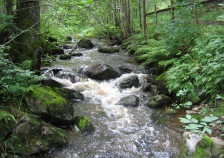Stömne nature reserve

Just a couple hundred meters from the house there is a nature reserve of about 30 hectares, characterized by deciduous forest. The nature reserve was founded to protect the large population of oak trees. The area is the most northern natural territory of this tree. Some of the oak trees are estimated to be between 300 and 500 years old. One of the biggest oak trees has been declared to be a natural monument. You even find other deciduous trees like ash, lime, and maple in the nature reserve. The high occurrence of ostrich fern is a sign of the nourishing environment. You even find touch-me-not balsam, moschatel, bittersweet nightshade, baneberry, chickweed, and hedge woundwort within the reserve. In April you can see daphne mezereum and hazel bloom on bare twigs. In May/June the oak trees are blossoming. The woodlands in the nature reserve are an important environment for insects, snails, mosses, lichen, and fungi.
Furthermore the area is characterized by its large bird population with e.g. nuthatch, blue tit and singing birds. Styggbäcken, a small stream, meanders through the reserve. Brown trouts, Eurasian minnows, and perches have been seen in this stream. Due to the fish population you often see herons in the Styggbäcken waiting to make a catch.
Hammarklätten is a hill fort from where you have an enormous view over the area. Ancient findings around Stömne prove that there already where settlements about 6000 years ago. One of the oldest ironworks around the Glafsfjorden was located in Stömne. Moreover there was a copper mine and a cellulose factory located in this area.
The reserve is easily accessible for visitors; you find trails, stairs, and bridges.

 deutsch
deutsch svenska
svenska